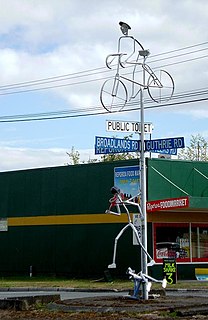
Wairoa is a town and territorial authority district in New Zealand's North Island. The town is the northernmost in the Hawke's Bay region, and is located on the northern shore of Hawke Bay at the mouth of the Wairoa River and to the west of Mahia Peninsula. It is 118 kilometres (73 mi) northeast of Napier, and 92 kilometres (57 mi) southwest of Gisborne. It is the largest town in the district of Wairoa, and is one of three towns in New Zealand where Māori outnumber other ethnicities, with 62.29% of the population identifying as Māori.

Wairakei is a small settlement, and geothermal area a few kilometres north of Taupo, in the centre of the North Island of New Zealand, on the Waikato River. It is part of the Taupo Volcanic Zone and features several natural geysers, hot pools. boiling mud pools, and the Wairakei Power Station, a major geothermal electric power generating station.
Gate Pa or Gate Pā is a suburb of Tauranga, in the Bay of Plenty Region of New Zealand's North Island.

Ōmokoroa is a small urban area in the Western Bay of Plenty District of New Zealand. The suburb is considered part of Greater Tauranga, and is within the Coromandel electorate. Ōmokoroa began as a small rural holiday village, but is expanding to be a commuter town, with a 25-minute drive to Tauranga City.

Reporoa is a rural community in Rotorua Lakes within the Waikato region of New Zealand's North Island.
Maraenui is a suburb of the city of Napier, in the Hawke's Bay region of New Zealand's eastern North Island.

Wharekahika / Hicks Bay, formerly called Hicks Bay, is a bay and coastal area in the Gisborne District of the North Island of New Zealand. It is situated 150 km east of Opotiki and 186 km north of Gisborne city, along State Highway 35 between Potaka and Te Araroa.
Awapuni is a suburb of the New Zealand city of Gisborne, located in the southwest of the city. It is named after the Awapuni lagoon, where the Waipaoa River runs into the ocean. The New Zealand Ministry for Culture and Heritage gives a translation of "blocked-up river" for Awapuni.
Manutuke is a settlement in the Gisborne District of New Zealand's North Island. It is located to the west of the city of Gisborne on State Highway 2, close to the mouth of the Waipaoa River.
Waioeka is a rural community in the Ōpōtiki District and Bay of Plenty Region of New Zealand's North Island.
Pongakawa is a rural community in the Bay of Plenty of New Zealand's North Island. State Highway 2 runs through it.
Waitahanui is a village in the Taupo District, Waikato region, New Zealand. The village is on the eastern shore of Lake Taupo, 14 km (9 mi) south of the district seat of Taupō.
Hexton or Manakauri is a village and rural area in the Gisborne District of New Zealand's North Island. It is located north-west of Gisborne City, and includes the settlements of Makauri and Waerengaahika.
Elgin is a suburb of Gisborne, in the Gisborne District of New Zealand's North Island. It is located east and north of Awapuni, south of Te Hapara and west of Gisborne Central.

Gisborne Central is the central business district and central suburb of Gisborne, in the Gisborne District of New Zealand's North Island. It is located east of Elgin, south of Whataupoko and west of Kaiti.
Maihiihi is a rural community in the Otorohanga District and Waikato region of New Zealand's North Island.
Camberley is a suburb of Hastings City, in the Hawke's Bay Region of New Zealand's North Island.
Frimley is a suburb of Hastings City, in the Hawke's Bay Region of New Zealand's North Island.

Maraekākaho is a rural settlement in the Hastings District and Hawke's Bay Region of New Zealand's North Island.
Aria is a rural community in the Waitomo District and Waikato region of New Zealand's North Island.







